Novel Solid-Phase Bioassay Kit with Immobilized Chlorella vulgaris Spheres for Assessing Heavy Metal and Cyanide Toxicity in Soil
Abstract
1. Introduction
2. Materials and Methods
2.1. Algae Culture
2.2. Algae Ball Preparation
2.3. Experimental Setup
2.4. Chemicals and Analysis
2.5. Statistical Analysis
3. Results and Discussion
3.1. Algal Ball Optimization for Solid-Phase Toxicity Test Kit
3.2. Heavy Metal-Induced Soil Toxicity Using Solid-Phase Algal Ball Toxicity Test Kit
3.3. Suitability of Solid-Phase Microalgae Bioassay Kits for Soil Toxicity Assessment
4. Conclusions
Author Contributions
Funding
Institutional Review Board Statement
Informed Consent Statement
Data Availability Statement
Conflicts of Interest
References
- Abdu, N.; Abdullahi, A.A.; Abdulkadir, A. Heavy metals and soil microbes. Environ. Chem. Lett. 2017, 15, 65–84. [Google Scholar] [CrossRef]
- Hussain, F.; Hussain, I.; Khan, A.H.A.; Muhammad, Y.S.; Iqbal, M.; Soja, G.; Reichenauer, T.G.; Yousaf, S.J.E. Combined application of biochar, compost, and bacterial consortia with Italian ryegrass enhanced phytoremediation of petroleum hydrocarbon contaminated soil. Environ. Bot. 2018, 153, 80–88. [Google Scholar] [CrossRef]
- Khan, M.A.I.; Biswas, B.; Smith, E.; Naidu, R.; Megharaj, M. Toxicity assessment of fresh and weathered petroleum hydrocarbons in contaminated soil—A review. Chemosphere 2018, 212, 755–767. [Google Scholar] [CrossRef]
- Chung, M.; Hu, R.; Cheung, K.; Wong, M.H. Screening of PAHs and DDTs in sand and acrisols soil by a rapid solid-phase microalgal bioassay. Ecotoxicology 2007, 16, 429–438. [Google Scholar] [CrossRef]
- Chung, M.; Hu, R.; Wong, M.H.; Cheung, K.J.E. Comparative toxicity of hydrophobic contaminants to microalgae and higher plants. Ecotoxicology 2007, 16, 393–402. [Google Scholar] [CrossRef]
- Selivanovskaya, S.; Galitskaya, P.; Schnell, S.; Hung, Y.T. A comparison of microbial contact bioassay with conventional elutriate assays for evaluation of wastes hazard. Int. J. Environ. Waste Manag. 2010, 6, 183–196. [Google Scholar] [CrossRef]
- Maxam, G.; Rila, J.-P.; Dott, W.; Eisentraeger, A. Use of bioassays for assessment of water-extractable ecotoxic potential of soils. Ecotoxicol. Environ. Saf. 2000, 45, 240–246. [Google Scholar] [CrossRef]
- Popov, B.B.; Najman, S.; Hristova, V.K.; Ahmad, M.A. Inductively coupled plasma-optical emission spectroscopy (icp-oes) approach for the determination of heavy metals, metalloid and trace element in soil and vegetables. Indian Hortic. J. 2014, 4, 98–104. [Google Scholar]
- Liang, C. Application of Atomic Absorption Spectrometry in Soil Environmental Monitoring. Front. Soc. Sci. Technol. 2020, 2, 15. [Google Scholar]
- Baun, A.; Justesen, K.B.; Nyholm, N. Algal tests with soil suspensions and elutriates: A comparative evaluation for PAH-contaminated soils. Chemosphere 2002, 46, 251–258. [Google Scholar] [CrossRef]
- Aruoja, V.; Kurvet, I.; Dubourguier, H.C.; Kahru, A. Toxicity testing of heavy-metal-polluted soils with algae Selenastrum capricornutum: A soil suspension assay. Envrion. Toxicol. 2004, 19, 396–402. [Google Scholar] [CrossRef] [PubMed]
- Brouwer, H.; Murphy, T.; McArdle, L. A sediment-contact bioassay with Photobacterium phosphoreum. Environ. Toxicol. Chem. 1990, 9, 1353–1358. [Google Scholar] [CrossRef]
- Tung, K.K.; Scheibner, M.G.; Walbourn, C.C. The solid phase assay: New Microtox test procedure. In Proceedings of the 17th Annual Aquatic Toxicity Workshop, Vancouver, BC, Canada, 5–7 November 1990. [Google Scholar]
- Boularbah, A.; Morel, J.L.; Bitton, G.; Mench, M. A direct solid-phase assay specific for heavy-metal toxicity. II. Assessment of heavy-metal immobilization in soils and bioavailability to plants. J. Soil Cont. 1996, 5, 395–404. [Google Scholar] [CrossRef]
- Eom, H.; Ashun, E.; Toor, U.A.; Oh, S.E. A solid-phase direct contact bioassay using sulfur-oxidizing bacteria (SOB) to evaluate toxicity of soil contaminated with heavy metals. Sens. Actuators B Chem. 2020, 305, 127510. [Google Scholar] [CrossRef]
- Adams, M.S.; Stauber, J.L. Development of a whole-sediment toxicity test using a benthic marine microalga. Environ. Toxicol. Chem. 2004, 23, 1957–1968. [Google Scholar] [CrossRef]
- Bozeman, J.; Koopman, B.; Bitton, G. Toxicity testing using immobilized algae. Aquat. Toxicol. 1989, 14, 345–352. [Google Scholar] [CrossRef]
- Zhang, L.J.; Ying, G.G.; Chen, F.; Zhao, J.L.; Wang, L.; Fang, Y.X. Development and application of whole-sediment toxicity test using immobilized freshwater microalgae Pseudokirchneriella subcapitata. Envrion. Toxicol. Chem. 2012, 31, 377–386. [Google Scholar] [CrossRef]
- Hussain, F.; Eom, H.; Toor, U.A.; Lee, C.S.; Oh, S.E. Rapid assessment of heavy metal-induced toxicity in water using micro-algal bioassay based on photosynthetic oxygen evolution. Environ. Eng. Res. 2020, 26, 200391. [Google Scholar] [CrossRef]
- Malapascua, J.R.F.; Jerez, C.G.; Sergejevová, M.; Figueroa, F.L.; Masojídek, J. Photosynthesis monitoring to optimize growth of microalgal mass cultures: Application of chlorophyll fluorescence techniques. Aquat. Biol. 2014, 22, 123–140. [Google Scholar] [CrossRef]
- Stirbet, A.; Govindjee. On the relation between the Kautsky effect (chlorophyll a fluorescence induction) and photosystem II: Basics and applications of the OJIP fluorescence transient. J. Photochem. Photobiol. B. Biol. 2011, 104, 236–257. [Google Scholar] [CrossRef]
- Torzillo, G.; Vonshak, A. Environmental Stress Physiology with Reference to Mass Cultures. In Handbook of Microalgal Culture: Applied Phycology and Biotechnology; Blackwell Publishing Ltd.: Hoboken, NJ, USA, 2013; pp. 90–113. [Google Scholar] [CrossRef]
- Zushi, K.; Kajiwara, S.; Matsuzoe, N. Chlorophyll a fluorescence OJIP transient as a tool to characterize and evaluate response to heat and chilling stress in tomato leaf and fruit. Sci. Hortic. 2012, 148, 39–46. [Google Scholar] [CrossRef]
- Kong, L. Copper requirement and acquisition by marine microalgae. Microorganisms 2022, 10, 1853. [Google Scholar] [CrossRef]
- Vojvodić, S.; Stanić, M.; Zechmann, B.; Dučić, T.; Žižić, M.; Dimitrijević, M.; Jelena, D.L.; Milica, R.M.; Jon, K.P. Mechanisms of detoxification of high copper concentrations by the microalga Chlorella sorokiniana. Biochem. J. 2020, 477, 3729–3741. [Google Scholar] [CrossRef]
- Megharaj, M.; Venkateswarlu, K.; Rao, A.S. Effect of monocrotophos and quinalphos on soil algae. Environ. Pollut. A Ecol. Biol. 1986, 40, 121–126. [Google Scholar] [CrossRef]
- Megharaj, M.; Venkateswarlu, K.; Rao, A.S. Growth response of four species of soil algae to monocrotophos and quinalphos. Environ. Pollut. A Ecol. Biol. 1986, 42, 15–22. [Google Scholar] [CrossRef]
- Megharaj, M.; Venkateswarlu, K.; Rao, A.S. The toxicity of phenolic compounds to soil algal population and to Chlorella vulgaris and Nostoc linckia. Plant Soil 1986, 96, 197–203. [Google Scholar] [CrossRef]
- Hammel, W.; Steubing, L.; Debus, R. Assessment of the ecotoxic potential of soil contaminants by using a soil-algae test. Ecotoxicol. Environ. Safe 1998, 40, 173–176. [Google Scholar] [CrossRef]
- Hosikian, A.; Lim, S.; Halim, R.; Danquah, M.K. Chlorophyll extraction from microalgae: A review on the process engineering aspects. Int. J. Chem. Eng. 2010, 2010, 391632. [Google Scholar] [CrossRef]
- Nam, S.H.; An, Y.J. Cell size and the blockage of electron transfer in photosynthesis: Proposed endpoints for algal assays and its application to soil alga Chlorococcum infusionum. Chemosphere 2015, 128, 85–95. [Google Scholar] [CrossRef]
- Lee, J.; Hong, S.; An, S.A.; Khim, J.S. Methodological advances and future directions of microalgal bioassays for evaluation of potential toxicity in environmental samples: A review. Environ. Int. 2023, 173, 107869. [Google Scholar] [CrossRef]
- Caesar, J.; Alexandra, T.; Nina, R.; Anna, L.L.; Bettina, W. Revisiting chlorophyll extraction methods in biological soil crusts–methodology for determination of chlorophyll a and chlorophyll a + b as compared to previous methods. Biogeosciences 2018, 5, 1415–1424. [Google Scholar] [CrossRef]
- ASTM D3978-21a; Standard Practice for Algal Growth Potential Testing with Pseudokirchneriella subcapitata. American Society for Testing and Materials (ASTM): West Conshohocken, PA, USA, 2012.
- European Commission (EC). C.3. Algal Inhibition Test; Office for Official Publications of the European Communities: Luxembourg, 1992.
- ISO 8692:2012; Water Quality—Fresh Water Algal Growth Inhibition Test with Unicellular Green Algae. International Organization for Standardization (ISO): Geneva, Switzerland, 2012.
- Organisation for Economic Co-Operation and Development (OECD). Test No. 201: Freshwater Alga and Cyanobacteria, Growth Inhibition Test. In OECD Guidelines for the Testing of Chemicals; Organisation for Economic Co-operation and Development: Paris, France, 2011. [Google Scholar]
- Robidoux, P.Y.; Gong, P.; Sarrazin, M.; Bardai, G.; Paquet, L.; Hawari, J.; Dubois, C.; Sunahara, G.I. Toxicity assessment of contaminated soils from an antitank firing range. Ecotoxicol. Environ. Saf. 2004, 58, 300–313. [Google Scholar] [CrossRef] [PubMed]
- Antunes, S.C.; Pereira, J.L.; Cachada, A.; Duarte, A.C.; Gonçalves, F.; Sousa, J.P.; Pereira, R. Structural effects of the bioavailable fraction of pesticides in soil: Suitability of elutriate testing. J. Hazard. Matter. 2010, 184, 215–225. [Google Scholar] [CrossRef] [PubMed]
- Maisto, G.; Manzo, S.; De Nicola, F.; Carotenuto, R.; Rocco, A.; Alfani, A. Assessment of the effects of Cr, Cu, Ni and Pb soil contamination by ecotoxicological tests. J. Environ. Monit. 2011, 13, 3049–3056. [Google Scholar] [CrossRef]
- Marques, C.; Pereira, R.; Gonçalves, F. Toxicity evaluation of natural samples from the vicinity of rice fields using two trophic levels. Environ. Monit. Assess. 2011, 180, 521–536. [Google Scholar] [CrossRef]
- Nam, S.H.; An, Y.J. An efficient and reproducible method for improving growth of a soil alga (Chlorococcum infusionum) for toxicity assays. J. Microbiol. Methods 2015, 119, 59–65. [Google Scholar] [CrossRef]
- Bulich, A.; Greene, M.S. Underwood, Measurement of soil and sediment toxicity to bioluminescent bacteria when in direct contact for a fixed time period. In Memorias de Water Environment Federation, 65th Annual Conference and Exposition; Weftec: Alexandria, VA, USA, 1992. [Google Scholar]
- Kwan, K.K. Direct toxicity assessment of solid phase samples using the Toxi-Chromotest kit. Environ. Toxicol. Water Qual. 1993, 8, 223–230. [Google Scholar] [CrossRef]
- Bitton, G.; Garland, E.; Kong, I.C.; Morel, J.L.; Koopman, B.J.S.; Contamination, S. A direct solid-phase assay specific for heavy metal toxicity. I. Methodology. J. Soil Contam. 1996, 5, 385–394. [Google Scholar] [CrossRef]
- Pei, Z.T.; Xu, R.R.; Liu, H.Y.; Wang, W.Q.; Zhang, M.; Zhang, L.L.; Zhang, J.; Wang, W.Q.; Yu, R.; Sun, L.W. Development and application of a novel whole sediment toxicity test using immobilized sediment and Chlorella vulgari. Ecotoxicol. Environ. Saf. 2020, 189, 109979. [Google Scholar] [CrossRef]
- Nam, S.H.; Kwak, J.I.; An, Y.J. Quantification of silver nanoparticle toxicity to algae in soil via photosynthetic and flow-cytometric analyses. Sci. Rep. 2018, 8, 292. [Google Scholar] [CrossRef]
- Egorova, K.S.; Ananikov, V.P. Toxicity of metal compounds: Knowledge and myths. Organometallics 2017, 36, 4071–4090. [Google Scholar] [CrossRef]
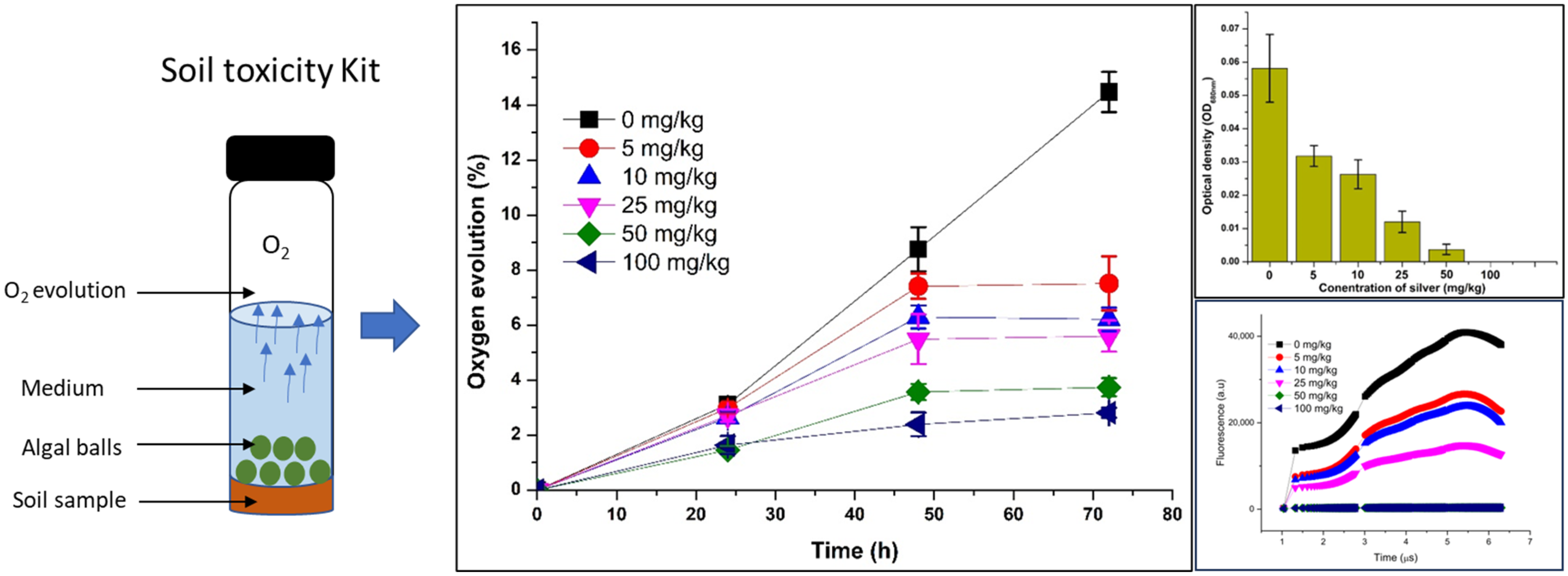

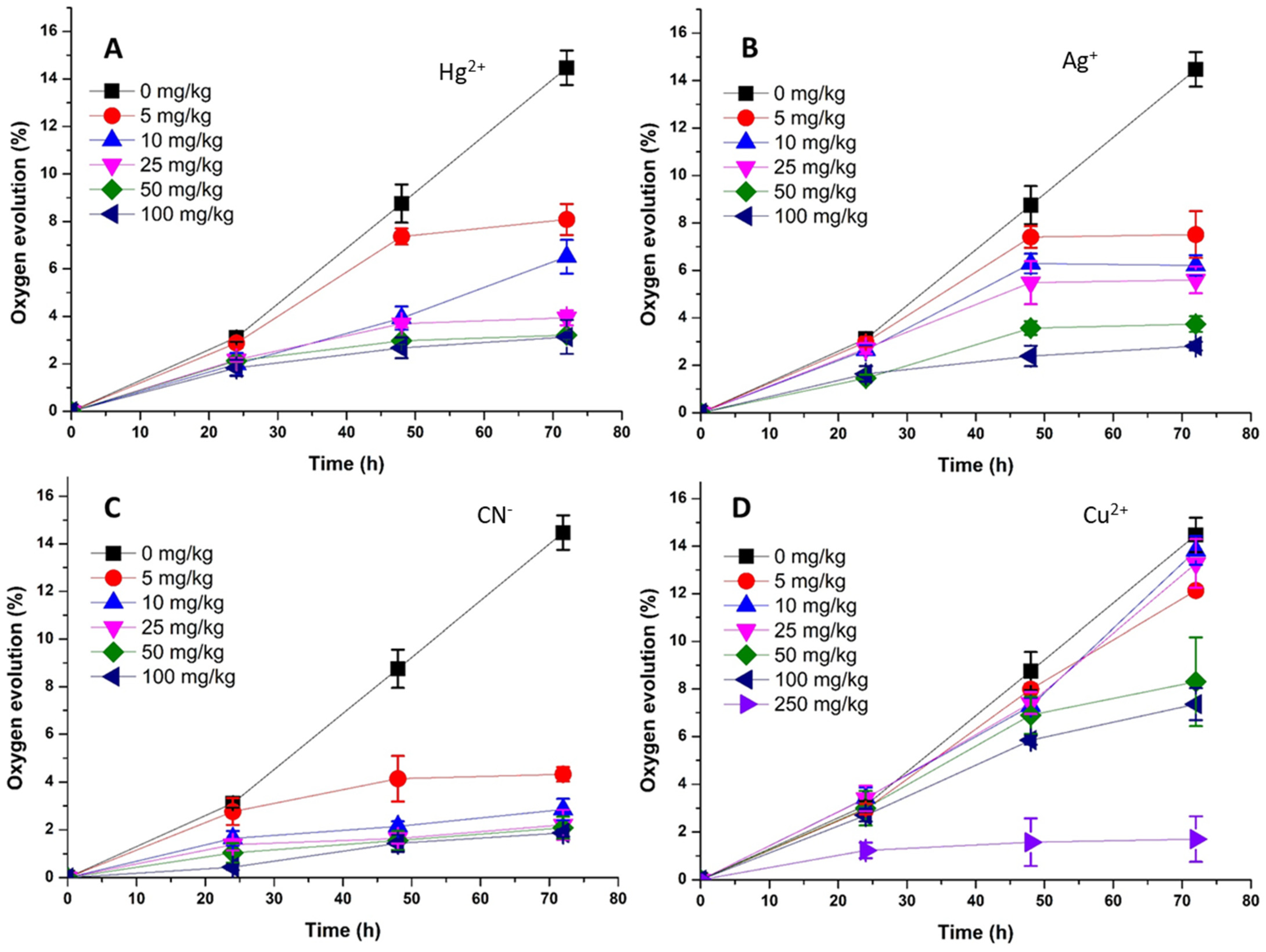
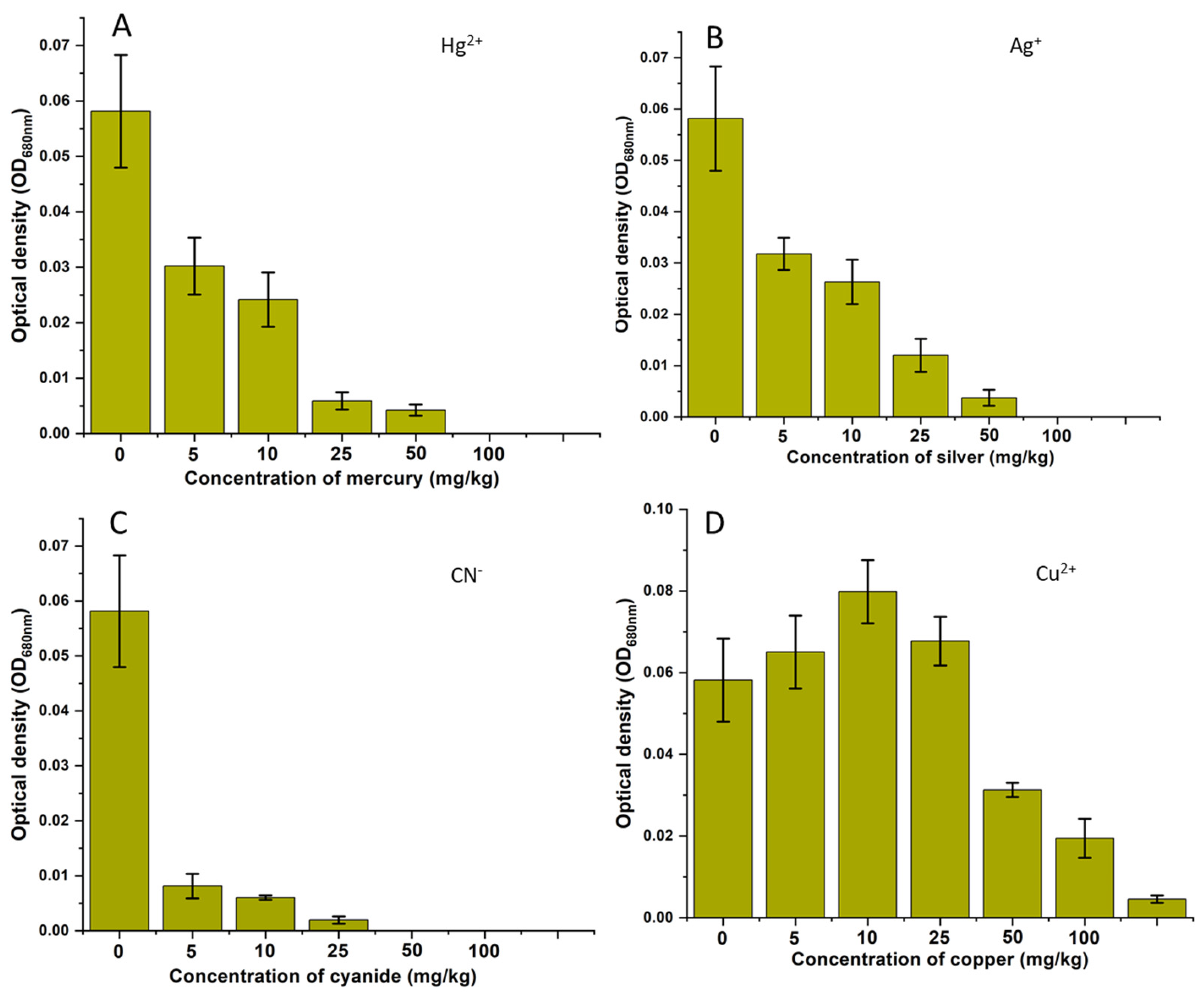
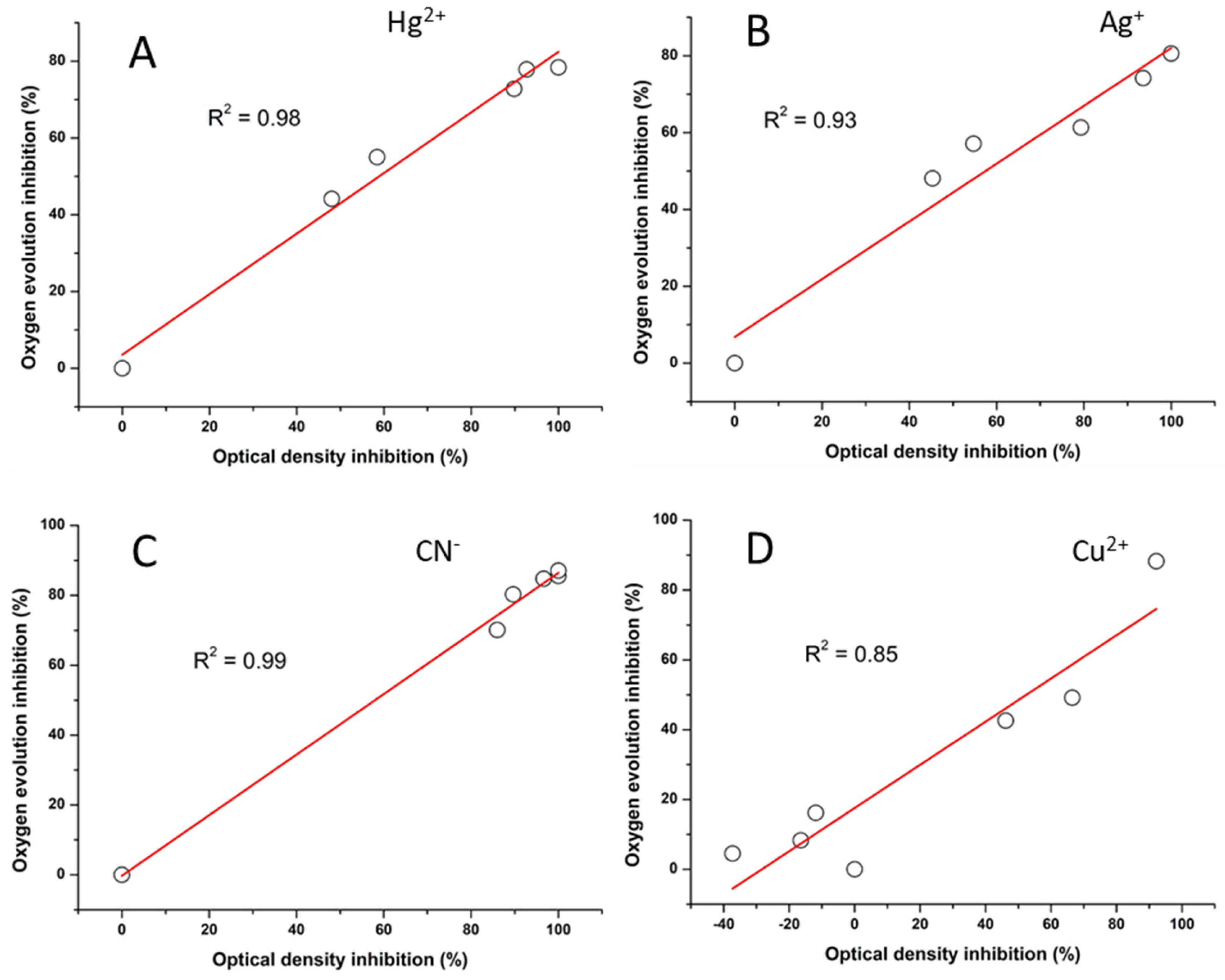
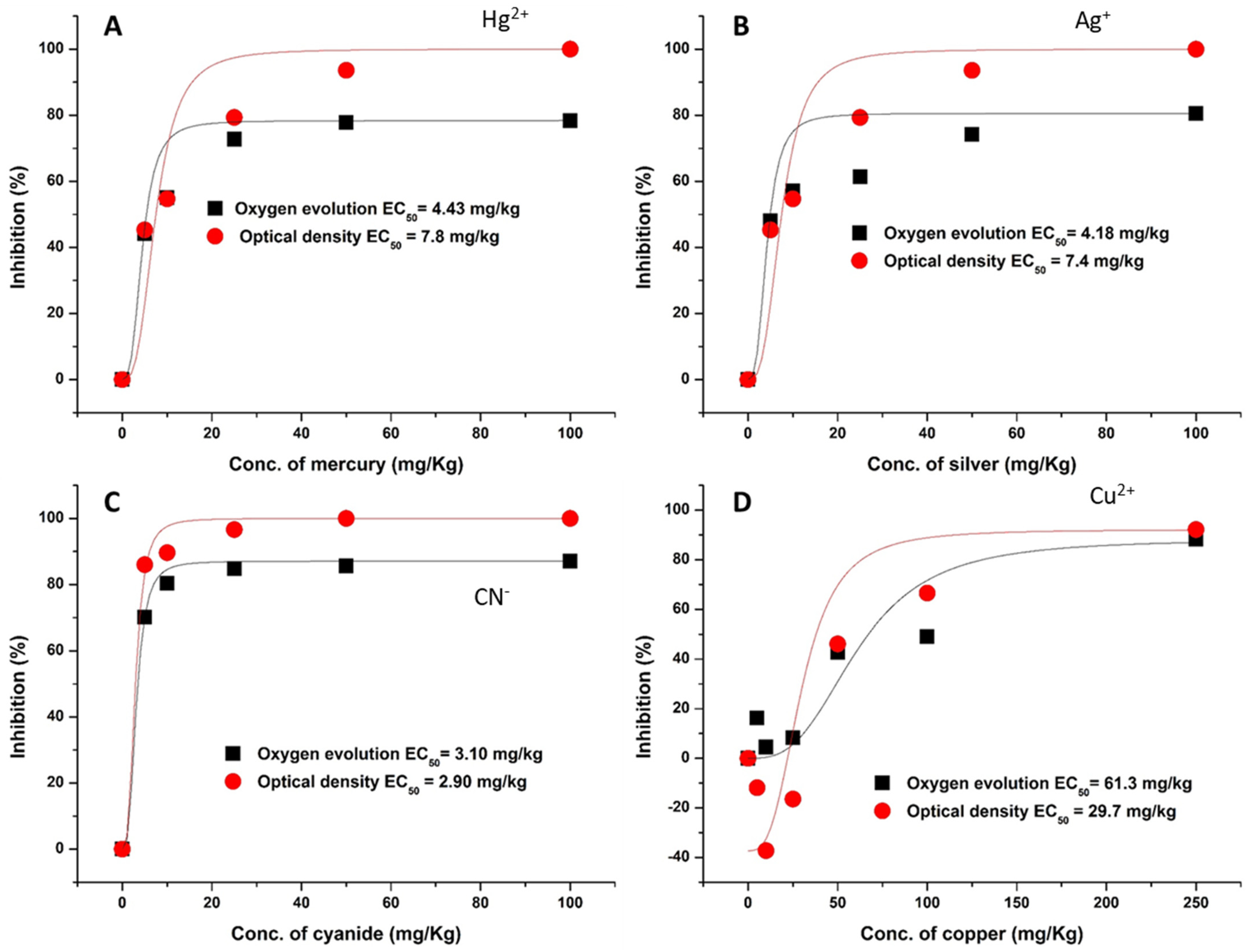
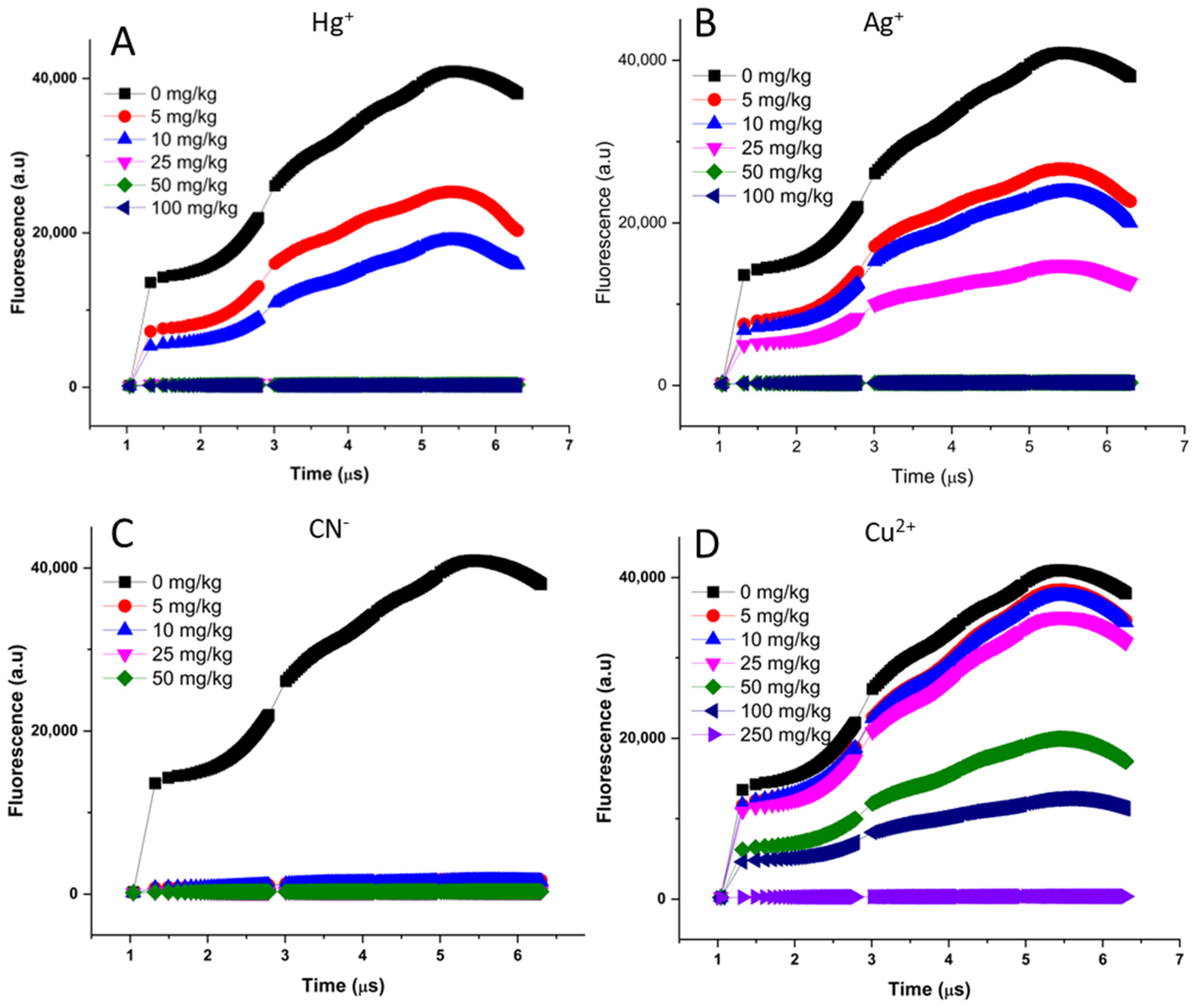
Disclaimer/Publisher’s Note: The statements, opinions and data contained in all publications are solely those of the individual author(s) and contributor(s) and not of MDPI and/or the editor(s). MDPI and/or the editor(s) disclaim responsibility for any injury to people or property resulting from any ideas, methods, instructions or products referred to in the content. |
© 2025 by the authors. Licensee MDPI, Basel, Switzerland. This article is an open access article distributed under the terms and conditions of the Creative Commons Attribution (CC BY) license (https://creativecommons.org/licenses/by/4.0/).
Share and Cite
Hussain, F.; Shahzad, S.; Mehdi, S.E.H.; Sharma, A.; Pandey, S.; Kang, W.; Oh, S.-E. Novel Solid-Phase Bioassay Kit with Immobilized Chlorella vulgaris Spheres for Assessing Heavy Metal and Cyanide Toxicity in Soil. Chemosensors 2025, 13, 193. https://doi.org/10.3390/chemosensors13060193
Hussain F, Shahzad S, Mehdi SEH, Sharma A, Pandey S, Kang W, Oh S-E. Novel Solid-Phase Bioassay Kit with Immobilized Chlorella vulgaris Spheres for Assessing Heavy Metal and Cyanide Toxicity in Soil. Chemosensors. 2025; 13(6):193. https://doi.org/10.3390/chemosensors13060193
Chicago/Turabian StyleHussain, Fida, Suleman Shahzad, Syed Ejaz Hussain Mehdi, Aparna Sharma, Sandesh Pandey, Woochang Kang, and Sang-Eun Oh. 2025. "Novel Solid-Phase Bioassay Kit with Immobilized Chlorella vulgaris Spheres for Assessing Heavy Metal and Cyanide Toxicity in Soil" Chemosensors 13, no. 6: 193. https://doi.org/10.3390/chemosensors13060193
APA StyleHussain, F., Shahzad, S., Mehdi, S. E. H., Sharma, A., Pandey, S., Kang, W., & Oh, S.-E. (2025). Novel Solid-Phase Bioassay Kit with Immobilized Chlorella vulgaris Spheres for Assessing Heavy Metal and Cyanide Toxicity in Soil. Chemosensors, 13(6), 193. https://doi.org/10.3390/chemosensors13060193






